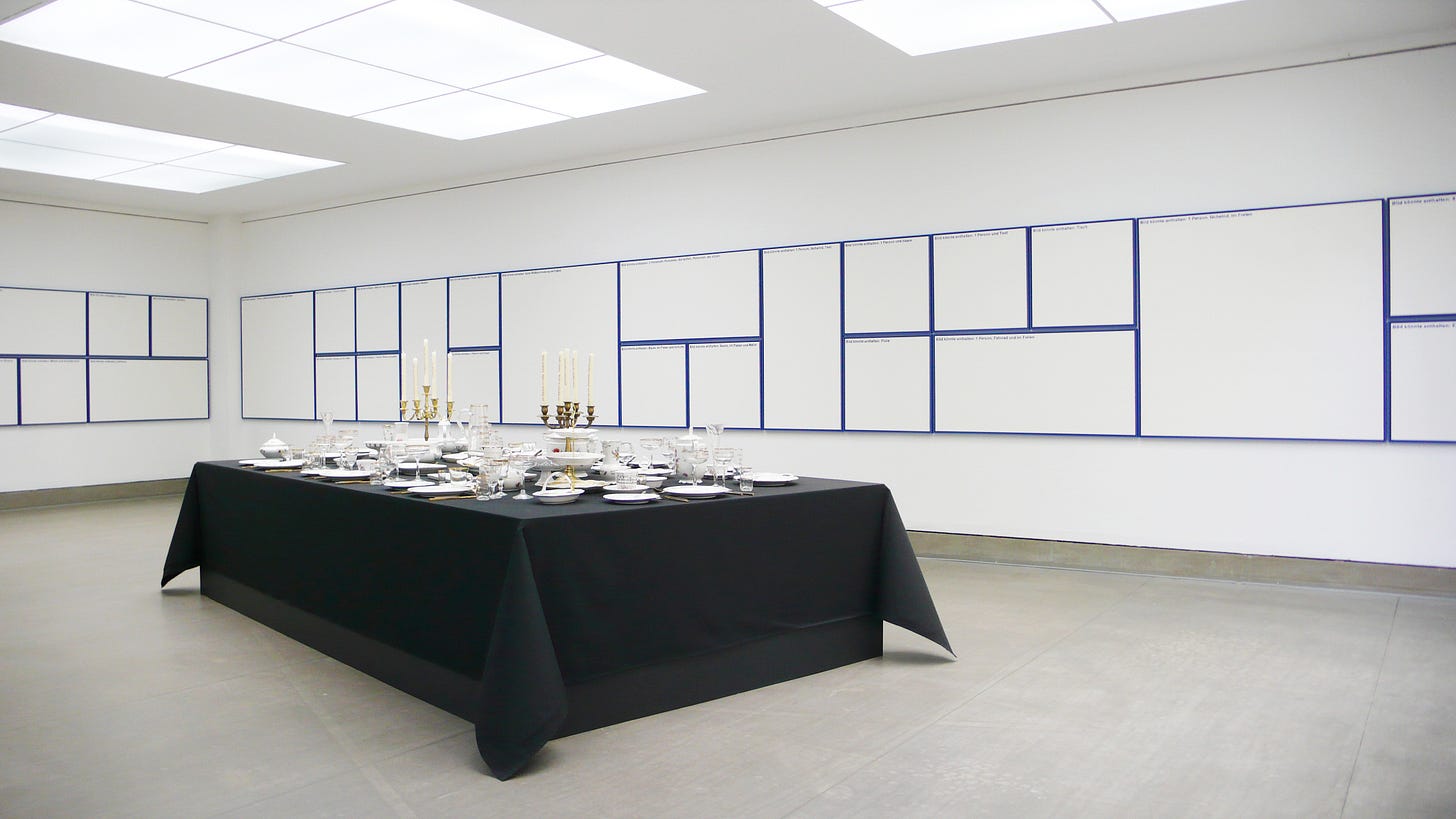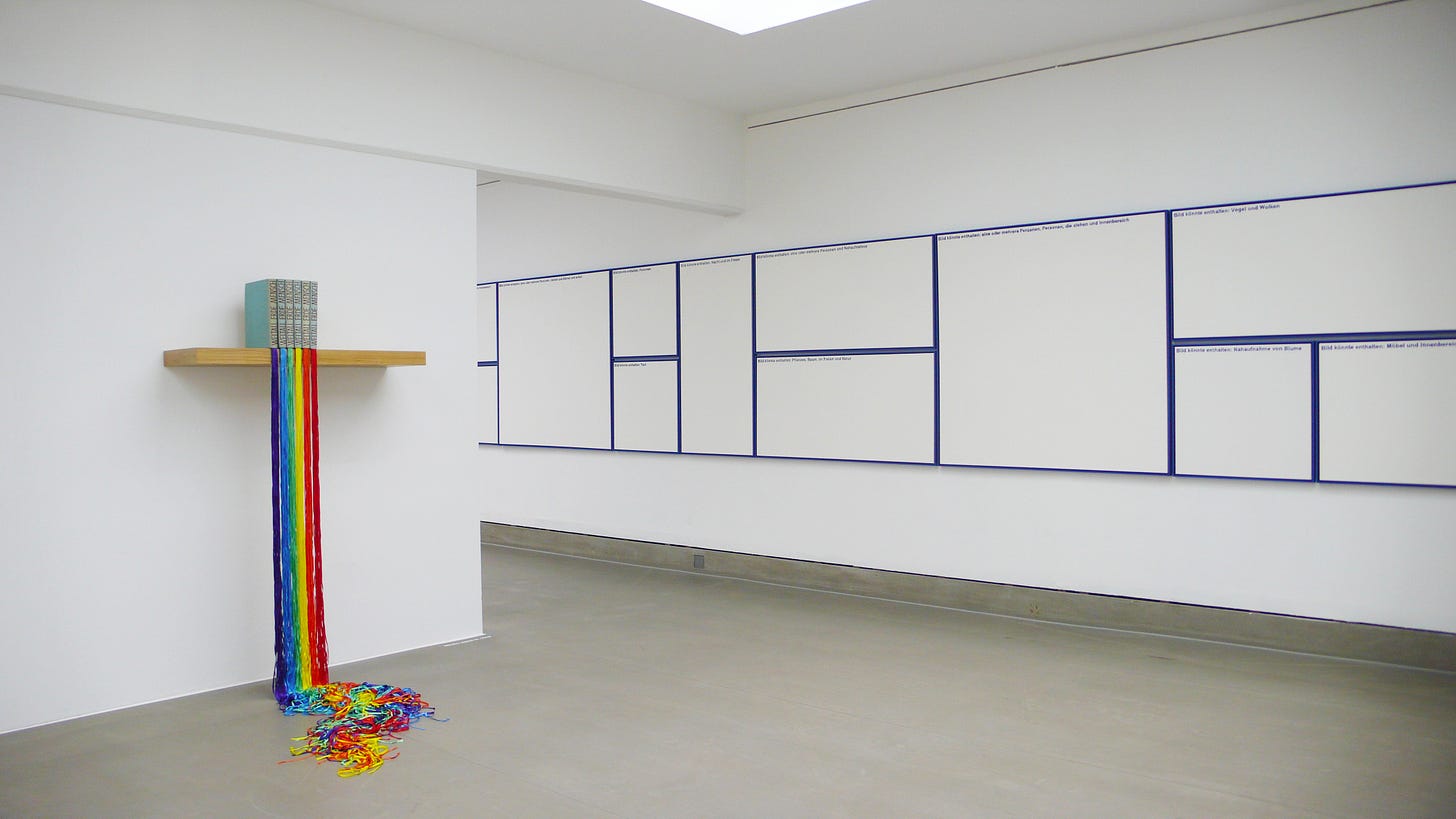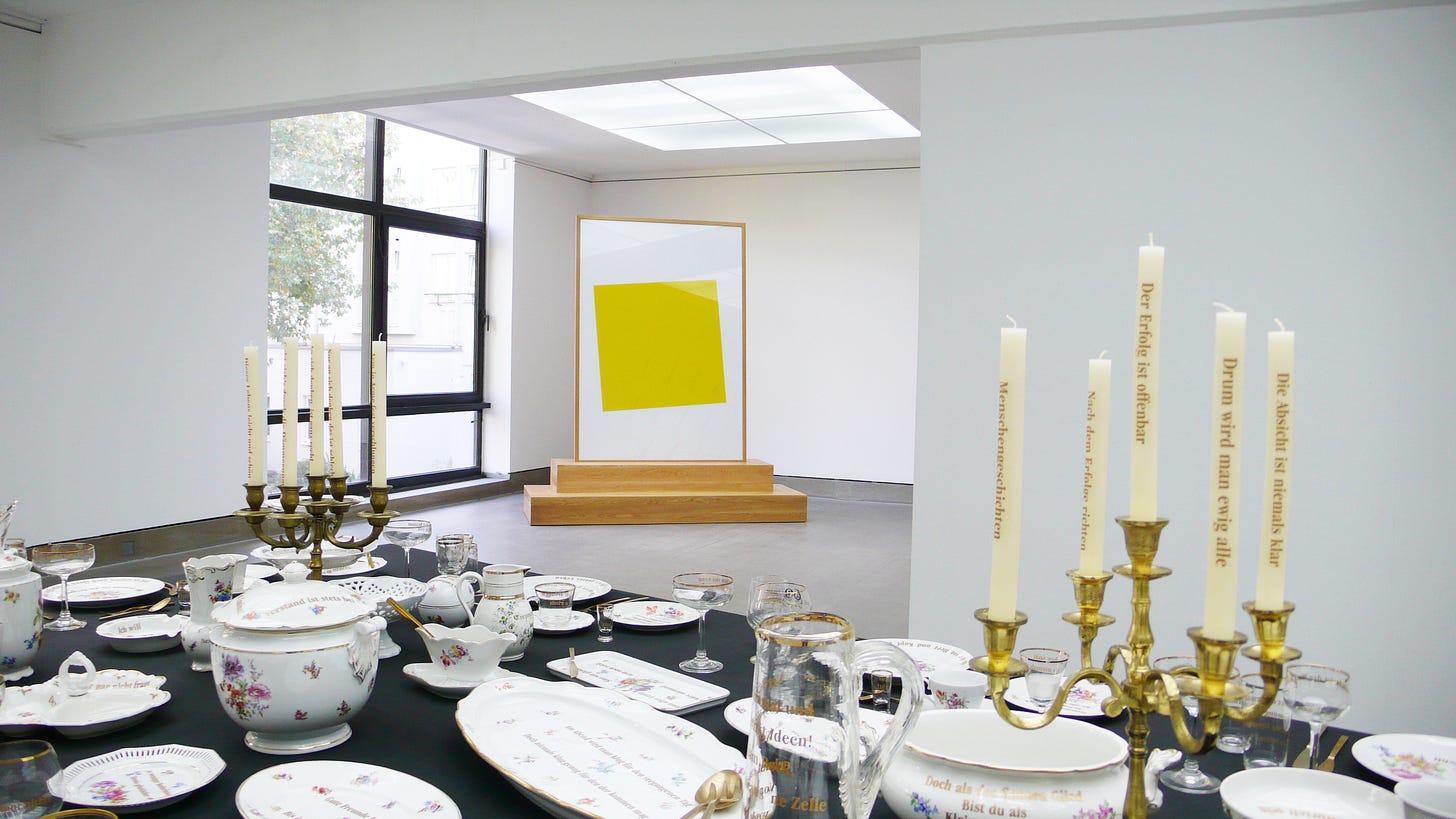Frenzy Höhne & The United States of Germany
On consumerism, kitsch, the national anthem, and what's lost in translation.
This week, I reviewed the show in German and English. Click here to access the German review of Frenzy’s show.
You Know I’ve got Language Barriers (to quote Kendrick)
Writing about this exhibition, I kept thinking of what it means to negotiate its content for a non-German audience. Frenzy (Millennial, German) is playing one pun after another, one reference to German quirkiness follows the other. I fear that so much is lost in translation. But that’s inevitably the case once you put art into words, no matter the language.
In a course on the connections between economy and art, I recently read an excerpt from After Art (2012) by David Joselit (Gen X, American). He makes this (I hope satirical) argument:
“This is what the contemporary global artwork must be: an emissiary, whose power arises out of cultural translation rather than avant-garde innovation, a form of international currency that can cross borders effortlessly.” (p. 21)
I cringed at most of Dave’s statements while reading, especially this one. Why would contemporary art only be legitimate if it’s understandable internationally? “Internationally” meaning a Western, US-American audience, of course. Is there no value in local contexts? Must everything be an easily interchangeable currency the way Dave suggests?
According to him, powerful art (whatever that means) is cross-cultural, mentioning Wang Guangyi (Baby Boomer, Chinese) whose works “have the perfect formula for success in a global art world: they carry a quantum of native ‘Chineseness’, but their mobilization of familiar Western art styles makes it possible for them to communicate this unfamiliar and even ‘exotic’ content to a broad range of audiences with little knowledge of China” (p. 20).
If your eyebrow is raised like Dwayne The Rock Johnson’s, same. Reading these statements, I want to frantically push the siren button on my Vine soundboard. But that’s an attitude somehow present in art criticism, too. Most outlets don’t try to build that bridge. It’s easier to write about exhibitions and art that an audience can already relate to in some form. If there’s no connection point, the critic may take on the awkward role of explaining the joke while “you just should have been there”.
So what’s the solution? The German-speaking kids merrily laugh at the inside joke while everyone else is standing in the rain looking through the windows? I can’t point out all the nuances laid into Frenzy’s work. I don’t want to attempt a full translation. But I hope to share my perspective of why I as a German girlypop resonate with her art. Let’s give it a try!
Happy Birthday, Deutschland!
I coincidentally went to Frenzy’s exhibition one day after German Unity Day on October 3. I’m publishing this review coincidentally one day after November 9 commemorating both the Nazi pogroms and the Fall of the Berlin Wall. Guys, I really didn’t plan this. But there couldn’t have been a better time to write about the work I saw there:
The melody of our national anthem plays from broomstick holders wrapped in German flags stuck to the wall. Well, it’s not so much the melody, but rather a cursed version that comes very close to the meme version of the Home Alone theme tune. The work is called Einheit [Unity] (2009), ironically. Frenzy adds another pole for every year since 1989. She limited their number in the exhibition, though. The conflicting sounds roll over into a never-ending canon at school orchestra level. You're doing amazing, sweetie! But is the national-anthem-opening unity in the room with us?

*Sigh* Okay, I’ll have to explain a pun here. The German word Einigkeit, as in the national anthem, means both unity and “being in agreement” over something. And Germans agree on disagreeing on the unity of East and West. Incidentally, the sticks are angled. There's something unpleasant about a saluting outstretched arm iconic for a greeting introduced by that one failed artist.
Diagonally across — Denkmal [Monument] (2012): The frame and pedestal are made of oak, historically a material coopted by the Hugo Boss suit people of the 1930s… What does this monument commemorate? A comically large pic of a Post-it. An empty one. We Germans love our ✨culture of remembrance✨. That’s what we excel at. Allegedly. But...what exactly are we supposed to remember? I forgor 💀.
What memory is our often-invoked culture of remembrance supposed to uphold? That David Hasselhoff's concert singlehandedly reunited a nation in 1989? That realities collapsed overnight? That the East finally stopped “being weird” and got back to “normal”? Is a sticky note enough against historical dementia?

[Insert Headline Here]
It remains empty in the paintings further back in the room. A panorama of white canvases with blue borders stretches across two walls. Frenzy titled this lil prank BILDER MACHEN LEUTE [Pictures make the man] (2020). Perhaps that's a stretch, but from a distance, I feel reminded of Piet Mondrian (1872-1944, American). Frenzy has painted a caption on each canvas about what said picture might contain: People, tree, person, shoe, laughing people, sitting people. Many repetitions. But none of this is actually depicted.
Makes me think of one of my favorite Instagram accounts, @perlendeslokaljournalismus. They collect the most absurd wording and hilarious fails of German journalism. Already published articles with un-updated temporary captions are a classic. It's also a bit like advertising that's usually pumped full of Shutterstock images that Frenzy stripped to the skeleton here. I read in the press kit that Frenzy uses “image descriptions [generated] on the internet for non-loadable image files”. Maybe I was thinking of newspapers rather than social media and stuff because of the formats. Brings me back to a controversy of art criticism: What’s the point of the translation into painting?

Ugh, tough one. A series of blank photos with the same captions would have done the job for the concept. I think it's an easy way out with painting. As if you still need “something classically artistic” to legitimize a concept and BOOM, you pull out a canvas. Mkay, if you insist... But while we were still on the subject of words...
You know the saying…
I turn around the corner and stand in front of a set table. Es ist angerichtet [It’s served] (2009), okay periodt! Frenzy uses fine old porcelain. White and delicately decorated with gold and flowers. Judging by the candles and the large number of dishes, it must be some important occasion. Anniversary glasses and wedding chalices are among them. What a shame, unfortunately, there are no grape scissors. Not that boujee, I guess. Each part of the table set is inscribed with all sorts of clever and wise words in gold lettering. I was so fixated on reading all the sayings that I didn't even notice the black tablecloth. Bit uncanny, innit? It’s giving coffee and cake after the funerary service. I know, I know, man does not live by bread alone and whatever, but are we gonna eat or did Frenzy just bring wisdom to the table?

There was another piece, NEUES LEBEN VII [New Life VII] (2019). Frenzy put six books on a shelf (she’s back at it again with oak). The book spine reads “WELTALL ERDE MENSCH” [Space Earth Human]. At first, I was dreading discussing this work, but then it got interesting: I googled the title on the book spine. This book really existed and was given away as a gift for the “Jugendweihe” or Youth consecration (we’re not getting into this rabbit hole here, though) in the GDR between 1954 and 1974. According to the extremely trustworthy source Wikipedia, “it is considered one of the most widely distributed printed works in the GDR” and explained the Marxist-Leninist worldview to kiddos back then. Frenzy lets a colored strand of ribbons grow out of each book. Together, these strands form a rainbow. When they reach the bottom, however, they become a jumble of colors again. Ain’t no leprechaun at the end of that rainbow…
It Ain’t Getting Betterer!
In the other room, I hear words of wisdom like the ones I read at the table earlier. A loudspeaker delivers one saying after another like mantras on a conveyor belt. Colorful, bright figurines inspired by Meissen porcelain are arranged on shelves as if for sale. What looks like the most ordinary cheap af plastic is actual painted porcelain, Frenzy calls these figures BESSERMENSCHEN [Better People] (2024). These typically aristocratic figurines carry tiny paper shopping bags with real advertising slogans. Doesn't Temu use the slogan Shop like a Billionaire? And does the porcelain high society really need to shop at discount stores with the ordinary peasantry?

Large textual works hang in the background. Frenzy stamped NEUERER [Newerer](2017) in endless repetition, exaggerating the grammatical comparative to absurdity. That’s our beautiful capitalist promise: There will always be something newerer. Right?
Curatorially, Frenzy keeps the red thread throughout the exhibition. Debatable lines of wisdom appear in both rooms, we got endless repetitions with the loop anthem there and the NEUERER pictures here. We also got ironic kitsch on porcelain both times. But just the way I keep doubting those white-blue paintings from earlier, I don't feel these NEUERER works. Frenzy combines concrete poetry as it has existed since at least the 1930s with consumer criticism. Well, that certainly worked just as well in the 60s and 70s. It’s over, right? But isn't that perhaps the point? There can be no newerer. I've said it before, every innovation is the well-forgotten old. What better way to express that than playing with what’s outdated?
Frenzy Höhne: NOCH BESSER LEBEN, through January 5, 2025 at gkg.
gkg - Gesellschaft für Kunst und Gestaltung Bonn
Hochstadenring 22
53119 Bonn
Webseite
Instagram: @gkg_bonn @frenzyhoehne
I hope you enjoyed this review. As a subscriber, you can share your thoughts in the comments and like my posts. In any case, feel free to share this review with someone, if you’d like to. Thanks!
See you soon!!!
Jennifer
The Gen Z Art Critic



